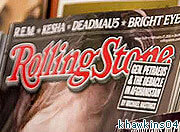Highly sexualised images of women in the media have soared in recent years and they are becoming increasingly explicit, according to researchers in America.
Images of women on the cover of Rolling Stone magazine were 89 per cent more likely to be sexualised or ‘pornified’ in the 2000s than in the 1960s, the study by the University of Buffalo revealed.
Researchers analysed more than a 1,000 images of men and women on the cover of Rolling Stone magazines over the course of 40 years.
Sexualised
The authors of the study concluded that though images of both men and women had become more sexualised over the years, sexualised images of women were more frequent.
One of the study’s authors, Assistant Professor of Sociology at Buffalo University, Erin Hatton, said: “In the 2000s there were 10 times more hyper-sexualised images of women than men, and 11 times more non-sexualised images of men than of women.
“What we conclude from this is that popular media outlets such as Rolling Stone are not depicting women as sexy musicians or actors; they are depicting women musicians and actors as ready and available for sex.”
Problematic
A number of recent studies warn that highly sexualised images in the media can cause damage to children.
Prof Hatton said it was problematic “because it indicates a decisive narrowing of media representations of women”.
She added: “We don’t necessarily think it’s problematic for women to be portrayed as ‘sexy.’ But we do think it is problematic when nearly all images of women depict them not simply as ‘sexy women’ but as passive objects for someone else’s sexual pleasure.
Violence
“Sexualised portrayals of women have been found to legitimise or exacerbate violence against women and girls, as well as sexual harassment and anti-women attitudes among men and boys.
“Such images also have been shown to increase rates of body dissatisfaction and/or eating disorders among men, women and girls; and they have even been shown to decrease sexual satisfaction among both men and women.”
Researchers developed a “scale of sexualisation” to analyse the images in the study, “Equal Opportunity Objectification? The Sexualisation of Men and Women on the Cover of Rolling Stone”.
The study will be published in the September issue of the journal Sexuality & Culture.

